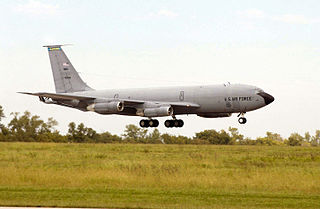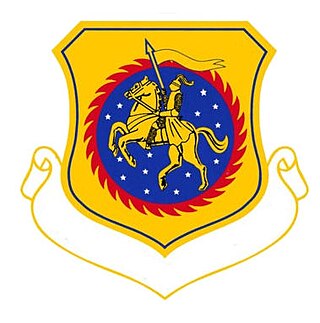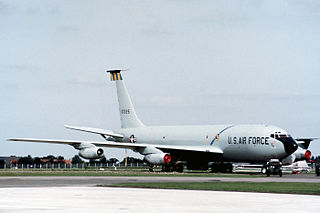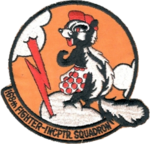
The 180th Airlift Squadron is a unit of the Missouri Air National Guard 139th Airlift Wing located at Rosecrans Air National Guard Base, St. Joseph, Missouri. The 180th is equipped with the C-130H2 Hercules.

The 168th Wing is a unit of the Alaska Air National Guard, stationed at Eielson Air Force Base, Fairbanks, Alaska. Before it was redesignated in February 2016, it was known as the 168th Air Refueling Wing. If activated to federal service as a USAF unit, the 168 WG is primarily gained by Pacific Air Forces, while its 213th Space Warning Squadron is gained by Air Force Space Command.

The 126th Air Refueling Wing is a unit of the Illinois Air National Guard, stationed at Scott Air Force Base, Belleville, Illinois. If activated to federal service, the Wing is gained by the United States Air Force Air Mobility Command.

The 453rd Bombardment Group is an inactive United States Air Force unit that was first organized in June 1943, during World War II, as a Consolidated B-24 Liberator heavy bomber group. After training in the United States, it deployed to England in December 1943, and, starting in February 1944, participated in the strategic bombing campaign against Germany with Eighth Air Force. Its 733d Bombardment Squadron completed 82 consecutive missions without a loss, a record for Eighth Air Force bomber units. James Stewart, of film fame, was group operations officer from 31 March to 1 July 1944. The group was programmed for redeployment to the Pacific and returned to the United States in May 1945 for training, however the Japanese surrender cancelled these plans and the group was inactivated in September 1945.

The 126th Air Refueling Squadron is a unit of the 128th Air Refueling Wing of the Wisconsin Air National Guard stationed at General Mitchell Air National Guard Base, Wisconsin. The 126th is equipped with the KC-135R Stratotanker.

The 117th Air Refueling Squadron is a unit of the Kansas Air National Guard 190th Air Refueling Wing located at Forbes Field Air National Guard Base, Topeka, Kansas. The 117th is equipped with the Boeing KC-135R Stratotanker.

The 55th Air Refueling Squadron is an inactive United States Air Force unit. It formerly operated both the combat crew training school and central flight instructor course for Boeing KC-135 Stratotanker at Altus Air Force Base, Oklahoma.

The 92nd Air Refueling Squadron, officially 92d Air Refueling Squadron, is a squadron of the 92nd Air Refueling Wing's 92nd Operations Group, stationed at Fairchild Air Force Base, Washington. It was first activated shortly before the entry of the United States into World War II as the 2nd Reconnaissance Squadron. After training in the Douglas B-18 Bolo in the southeastern United States, the squadron moved to the Pacific Coast after the Japanese attack on Pearl Harbor and participated in antisubmarine patrols with the Consolidated B-24 Liberator. In April 1942, it was redesignated the 392nd Bombardment Squadron. Starting in mid-1942, it also began training crews on the Liberator. It ended these operations in July 1943 and began to prepare for overseas movement. After three months of training, the squadron moved to the Central Pacific, where it flew its first combat mission in November. The 392nd continued combat operations until March 1945, when it was withdrawn and moved to Hawaii, where it conducted routine training and patrol operations until it was inactivated in November 1945.

The 93rd Air Refueling Squadron is an active United States Air Force unit, stationed at Fairchild Air Force Base, Washington, where it is assigned to the 92nd Operations Group and operates the Boeing KC-135 Stratotanker aircraft conducting air refueling missions.

The 96th Air Refueling Squadron was a unit of PACAF's 15th Wing at Joint Base Pearl Harbor–Hickam, Hawaii in partnership with the 203rd Air Refueling Squadron and 154th Maintenance Group of the Hawaii Air National Guard. It was inactivated on 3 September 2015.

The 97th Air Refueling Squadron is an active unit of the United States Air Force, stationed at Fairchild Air Force Base, Washington. It was most recently activated on 1 October 2019 and assigned to the 92nd Operations Group, 92nd Air Refueling Wing.

The 99th Air Refueling Squadron is part of the 6th Air Mobility Wing at MacDill Air Force Base, Florida, but is stationed at Birmingham Air National Guard Base, Alabama. It is an Active Associate Unit, an active duty component attached to the Alabama Air National Guard's 117th Air Refueling Wing. The 99th Air Refueling Squadron works with, supports and flies the 117th Air Refueling Wing's Boeing KC-135R Stratotanker aircraft.

The 906th Air Refueling Squadron is an active United States Air Force unit. It is an active associate squadron and part of the 375th Air Mobility Wing at Scott Air Force Base, Illinois.

The 307th Operations Group is an Air Reserve Component of the United States Air Force. It is assigned to the 307th Bomb Wing, Air Force Reserve Command, stationed at Barksdale Air Force Base, Louisiana.

The 97th Operations Group is a United States Air Force unit assigned to the 97th Air Mobility Wing of Air Education and Training Command. It is stationed at Altus Air Force Base, Oklahoma.

The 452d Operations Group is the flying component of the 452d Air Mobility Wing, assigned to the United States Air Force Reserve. The group is stationed at March Air Reserve Base, California.

The 319th Operations Group is a United States Air Force unit assigned to 319th Reconnaissance Wing, Air Combat Command. It is stationed at Grand Forks Air Force Base, North Dakota operating RQ-4 Global Hawk remotely piloted aircraft (RPA) in the intelligence, surveillance and reconnaissance (ISR) role.

The 407th Air Refueling Squadron is an inactive United States Air Force unit. It was last assigned to the 42nd Bombardment Wing at Loring Air Force Base, Maine, where it was inactivated on 1 October 1990.

The 904th Expeditionary Air Refueling Squadron is an inactive United States Air Force unit. It was last assigned to the 320th Bombardment Wing at Mather Air Force Base, California, where it was inactivated on 30 September 1986.

The 137th Special Operations Group is an associate unit of the Oklahoma Air National Guard stationed at Will Rogers Air National Guard Base. If activated for federal service, the group is gained by Air Force Special Operations Command.

































